GPB Originals
Browse by genre, featured programs, featured programs & series, more gpb news, for kids & teachers, ghsa sports, high school football, browse by type, browse by category, for parents & caregivers, support gpb.


Live Exploration: Okefenokee Swamp
Share this page.
Discover one of the last frontiers of true Georgia wilderness with GPB’s live exploration of the Okefenokee Swamp. Witness the power of the mighty alligator, hear from swamp experts as they answer questions from the audience, and test your knowledge of the Okefenokee with this hour-long program.
Tour the Okefenokee Swamp and interact with swamp experts during this live exploration.
Support Materials
Learn about how animals utilize what’s in their habitat to build their homes—and how they construct their shelters to stay alive in this video from NATURE: Animal Homes . Using video, text-dependent questions, and teaching tips, students gain a deeper understanding about animal habitats around the world.
Learn about the natural defense mechanism of camouflage as the Kratt brothers explore how it's used by walking sticks and chameleons. Viewers learn that chameleons move in a jerking motion to look like a leaf blowing in the wind and that they have swiveling eyes, enabling them to spot predators and prey.
This video segment from IdahoPTV's Science Trek reveals the many adaptations that prey have to avoid predators, and that predators have to catch prey. Students will discover how both depend on each other.
This video segment from IdahoPTV's Science Trek defines wetlands (slough, swamp, bog, marsh, and riparian zones) by their 3 characteristics: water, hydric soil, hydrophytes. It stresses why wetlands are critical for wildlife survival.
In this lesson, students play a series of online games in which they model how the plants and animals in an ecosystem depend on one another.
Don Berryhill, science specialist with the Okefenokee Regional Education Service Agency, guides students in a canoe through the Okefenokee Swamp and points out many unique species in this specialized ecosystem. Bill Cribbs, a descendant of a farmer who came to the Okefenokee in the late 1800s, and park ranger Pete Griffin describe life in the swamp when people worked at the Hebard Lumber Company. Like any mysterious place, legends abound, Cribbs and Griffin have a few stories to tell.
This virtual field trip takes students on a journey throughout the state of Georgia, guiding them through twelve of the state’s physical features and explaining the relative location of each, as well as their environmental characteristics, historical connections, and much more. Students will visit several physical featutes, including the Okefenokee Swamp in southeast Georgia.
Wetlands exemplify the structure and functions of ecosystems and how ecosystems change over time. In these videos, students meet wetland scientist Dan Fink, who hosts the program and examines the types of communities of plants, animals, birds and fish that abound in wetlands, the process of photosynthesis, and the complex relationship between water and productivity.
In this lesson plan, students examine some of the behaviors and physical characteristics that enable organisms to live successfully in their environment.
Fire is the result of different chemicals interacting. It can start with lightning, lava or a match, and how it burns depends upon three key things. What it leaves behind can be surprising.
The Indian Mounds experience includes virtual field trips to Ocmulgee National Monument, Kolomoki Mounds State Park, and Etowah Indian Mounds Historic Site.
In this media-rich lesson, students use a systems thinking approach to explore the components and processes of ecosystems. They analyze both a hypothetical and a local ecosystem by identifying abiotic and biotic components and their relationships.
In this lesson plan, students consider how animals solve the problem of finding food, especially under harsh climatic conditions.
Grades: 4-6
Katelyn and Blake are nuts about animals, especially reptiles! Katelyn is a junior volunteer at the Mississippi Museum of Natural Science in her hometown of Jackson, Mississippi. She knows a lot about reptiles. Here's a good question: What makes a good home for alligators?
Grades 9-12
Why is biodiversity important? Explore how healthy ecosystems provide crucial direct, indirect, and aesthetic-ethical benefits to humans.
What's the difference between diversity in genees and species? Why are some species better than others at adapting to environmental changes? Learn more about specific levels of biodiversity, and see examples of plant and animal species and why they are important to each level.
See how seasonal changes drive patterns in animal behavior. Track the movement of two migratory birds of prey—ospreys and turkey vultures—as they travel between North and South America over a single calendar year.
To understand why Jekyll Island is such a great place for sea turtles, it'll help to understand what an ecosystem is. Learn more about ecosystems in this Teachable Moment.
How can mammals survive hibernation? We may not know as much as we think. There are several myths about hibernation that are corrected in this seasonal science video.
In this interactive lesson, students discover what swamp gas is and why it is the reason behind the name Okefenokee, or “land of trembling earth.”
Connect with GPB Education
Explore the
Okefenokee Swamp
Something for everyone.
Explore the wildlife and vast wilderness, past Native American civilizations, pioneers and settlers, waterways and habitats of North America’s largest “blackwater” swamp. Whether you’re looking for a few hours of family fun by land or water, or whether you’re seeking a multi-day immersion in the solitude of the swamp’s 438,000 acres of natural splendor, we have something for everyone at our three unique swamp entrances.
Things to Do
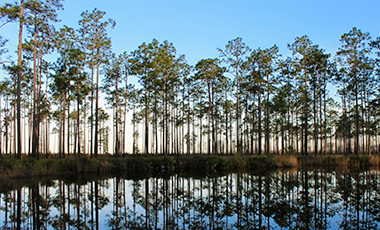
Auto Tour Route
Okefenokee National Wildlife Refuge
The Auto Tour Route, also known as the Swamp Island Drive at the Okefenokee National Wildlife Refuge, is a 7.2-mile paved road, which can be used by cars, bikes and walkers. This scenic route is a great way to experience the beauty of the refuge in a comfortable, stress-free way. The Swamp Island Drive provides access to several hiking trails as well as the Chesser Island Homestead and Chesser Island Boardwalk. Additionally, the Swamp Island Drive has an interpretive brochure to aid guests as they are learning about the flora, fauna, and history of the refuge.
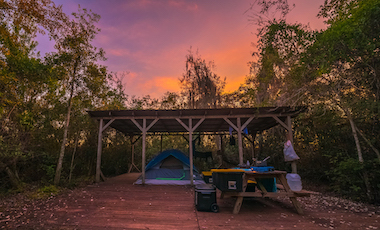
Stephen C. Foster State Park
Okefenokee National Wildlife Refuge Camping Permits
There are 63 tent and RV campsites within Stephen C. Foster State Park, offering many opportunities for visitors to experience the unique camping environment of the park. While camping, visitors are close to the park’s many activities, and astronomy enthusiasts can enjoy some of the best stargazing in the southeast.
A bucket list trip for visitors from around the globe, camping in the heart of the Okefenokee National Wildlife Refuge is an adventure for both the expert and the novice in the outdoors. A variety of overnight camping platforms and islands provides opportunities for camping from one-four nights in the swamp.
Photo credit: Jay Blanton
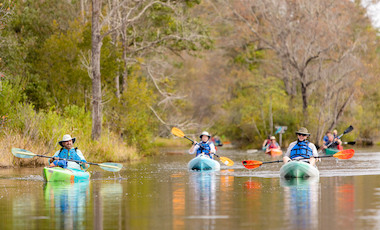
Canoeing, Kayaking & Boating
Okefenokee National Wildlife Refuge w/ Okefenokee Adventures
Okefenokee Swamp Park
Whether bringing your own boat or renting one, paddling, kayaking and boating is an unmatched opportunity to experience the swamp. Public boat launches, canoe, kayak and Jon boat rentals are available at both the Okefenokee National Wildlife Refuge and Stephen C. Foster State Park entrances, while the Okefenokee Swamp Park Paddle Sundays provide visitors at this entrance with an opportunity to rent kayaks or canoes on Sundays.
Photo credit: Chris Moncus
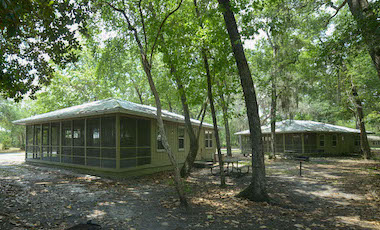
Visitors looking for a more home-like overnight experience at Stephen C. Foster State Park will find our park cottages a great alternative to camping. The cottages can hold 6-8 people, and some can accommodate wheelchairs, offering a comfortable and convenient overnight stay.
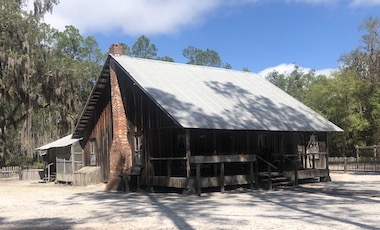
Cultural Sites/Interpretation
Cultural sites are available at all three swamp entrances, providing visitors with a window into the past cultures, history and activities within the resource-rich Okefenokee.
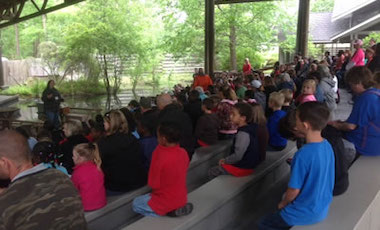
Daily Nature Shows
The Eye on Nature shows at the Okefenokee State Park are daily interactive experiences that teach visitors about the different native wildlife that make their homes in the park. These shows are held at the Okefenokee State Park Nature Center and/or the Lagoon Amphitheater and feature live animals, including snakes, turtles and even baby alligators.
- Next »
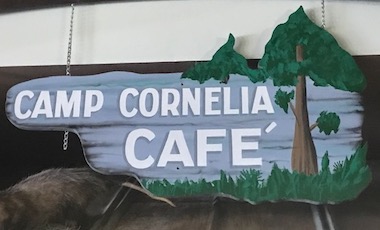
Camp Cornelia Café
Okefenokee Adventures
Cornelia Café is located in the Okefenokee National Wildlife Refuge and is operated by the Refuge onsite concessionaire, Okefenokee Adventures. The restaurant offers delicious food, including sandwiches, salads, vegetarian options, and low country shrimp boils, and is the perfect place to launch, relax or refuel for your swamp adventure.
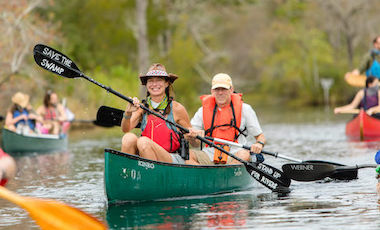
Okefenokee National Wildlife Refuge Wilderness Canoeing
Whether you bring your own boat (canoe/kayak, or boat w/ motor less than 10HP), or rent from Okefenokee Adventures, hitting the water trails is an unmatched opportunity to truly experience what the refuge has to offer. A public boat launch provides access to 120-miles of boating trails for day-use or overnight trips. Canoes, kayaks, and Jon boats are available to rent at Okefenokee Adventures for travelers that would like the experience of being out on the water trails, but do not have a boat of their own. All guests need to sign in/out if going out on the water – trail conditions change rapidly, check with either Okefenokee Adventures or the Visitor Center on the latest status of water levels and trail closures. Additional public boat launches at the Okefenokee National Wildlife Refuge are located at Kingfisher Landing and the Suwannee River Sill.
Chesser Island Homestead
Chesser Island Homestead is a living history museum showcasing structural necessities of self-sufficient living in the resource-rich Okefenokee from the 1850s through the 1950s. Walk the grounds of the Homestead to take a step back in time to the days of the early settlers. Volunteer docents offer tours of the inside of the house seasonally.
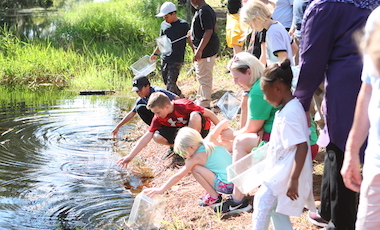
Educational Programs
Okefenokee National Wildlife Refuge - For Educators
Taking your class on a field trip to the Okefenokee National Wildlife Refuge is an incredible way to give your students an unforgettable, hands-on experience in nature. You can schedule a self-guided trip, take one of the guided tours, or request environmental education programs at the refuge.
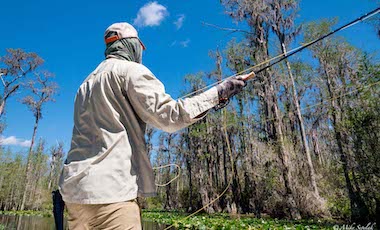
Fishing on National Wildlife Refuges
The Okefenokee National Wildlife Refuge provides exciting freshwater fishing opportunities for bream, catfish, bowfin, and even the occasional largemouth bass! A variety of different habitats are easily accessible from a boat, including many natural lakes and prairies, along with the Suwannee Canal, which offers deeper water than the rest of the swamp. All of the waters along the refuge’s water trails are open to fishing. Bank fishing opportunities are available along the Canepole Trail and around the refuge boat basin. State and refuge regulations apply.
Photo credit: Mike Sepelak
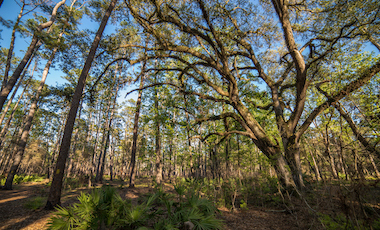
Billy’s Island
Accessed by boat through Stephen C. Foster State Park, this historic island in the Okefenokee has been inhabited by man for generations. Most recently, the Hebard Cypress Company had a lumber camp on the island in 1918, eventually supporting approximately 600 people. This island is the second largest in the swamp and is only accessible by boat.
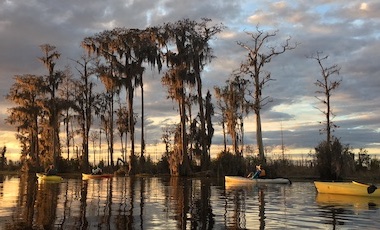
Canoeing, Kayaking and Boating
For adventurous visitors, canoe and kayak rentals are available to explore the waters of the swamp. Canoeing and kayaking allow for an up-close and personal experience of the swamp, and unparalleled wildlife viewing. As an alternative to canoes and kayaks, Stephen C. Foster State Park also offers Jon boat rentals for park visitors who are interested in further exploration of the swamp waters.
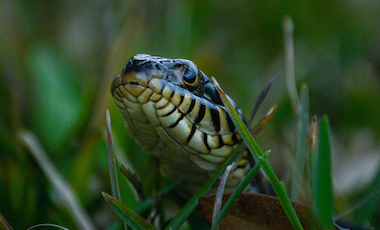
Stephen C. Foster State Park offers a variety of educational group experiences, including guided boat tours, paddle tours, and hiking. They also provide educational programs that cover topics including astronomy, reptiles, swamp topography, and more.
Stephen C. Foster State Park is a prime fishing location, particularly for warmouth, bluegill, catfish, chain pickerel and bowfin. Canoe, kayak and Jon boat rentals are available through the park, or visitors may bring their own.
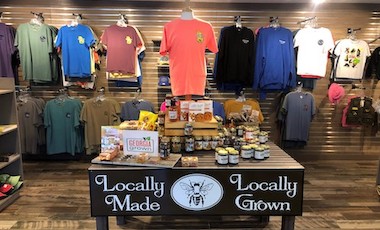
The gift shop at Stephen C. Foster State Park provides visitors a convenient way to shop for a variety of items, including apparel, food and snacks, camping supplies, souvenirs, and more.
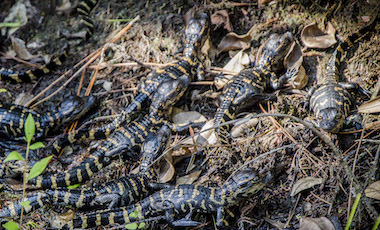
Boardwalks & Nature Center
Okefenokee Swamp Park offers and boardwalks, including one that takes visitors to the tallest observation tower in the swamp. The Nature Center is home to the serpentarium, which houses many different species of snake, as well as a family of bears, turtles, and baby alligators. The center also hosts a variety of interactive activities, including the Eye on Nature series.
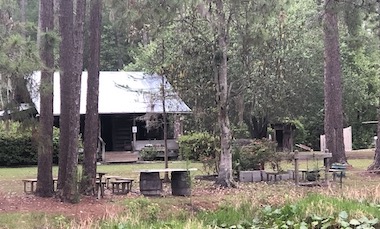
Opportunities for cultural interpretation at the Okefenokee Swamp Park include Vereen Bell Memorial Highway, Cowhouse Island, authentically recreated Timucua and Seminole residences, logging machinery, turpentine equipment, and a moonshine still from the 19th and early 20th centuries. Skull Lake, Pioneer Island and Wildes Cabin exhibits echo times of early Indian cultures, pioneers, movie making and major fires in the Okefenokee.
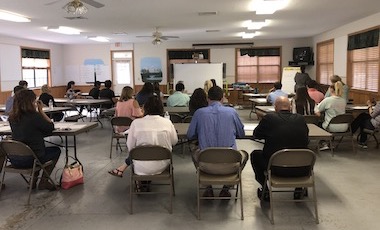
Cypress Cove Annex Group Space
Cypress Cove Annex is a beautiful facility, equipped to handle a variety of events, from business meetings to weddings. The Annex can comfortably hold up to 200 people, has a fully equipped kitchen, and is surrounded by the incredible wilderness of Okefenokee Swamp. Additional indoor meeting space is available at the park Nature Center, while outdoor meeting space includes the Pavilion, the Amphitheater and an outdoor wedding gazebo. Both Cypress Cove Annex and the Nature Center are connected to the internet with fiber optic cable.
Daily ‘Eye on Nature’ Shows
The Eye on Nature shows are daily interactive experiences that teach visitors about the different native wildlife that make their homes in the park. These shows are held at the Nature Center and/or the Lagoon Amphitheater and feature live animals, including snakes, turtles and even baby alligators.
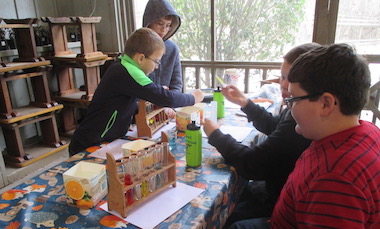
Okefenokee Swamp Park offers field trip reservations for school groups, and discounted guided tour rates for school trips. Reservations can be made four weeks or more in advance to allow your class an unforgettable outdoor education experience.
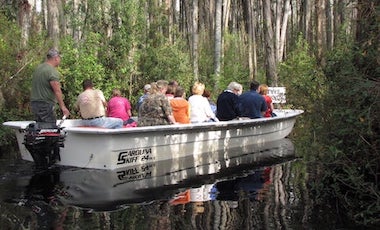
Guided Boat Excursions
Experienced tour guides take park visitors on a 45-minute boat ride through waterways, sharing their knowledge of the cultural and natural history of the area. These tours are a unique way to experience the beauty and history of the swamp, and to encounter some of the natural wildlife along the way. A Group Boat Tour is available too for groups of 12 or more. Reservations required.
Chart Your Course
Activity Map
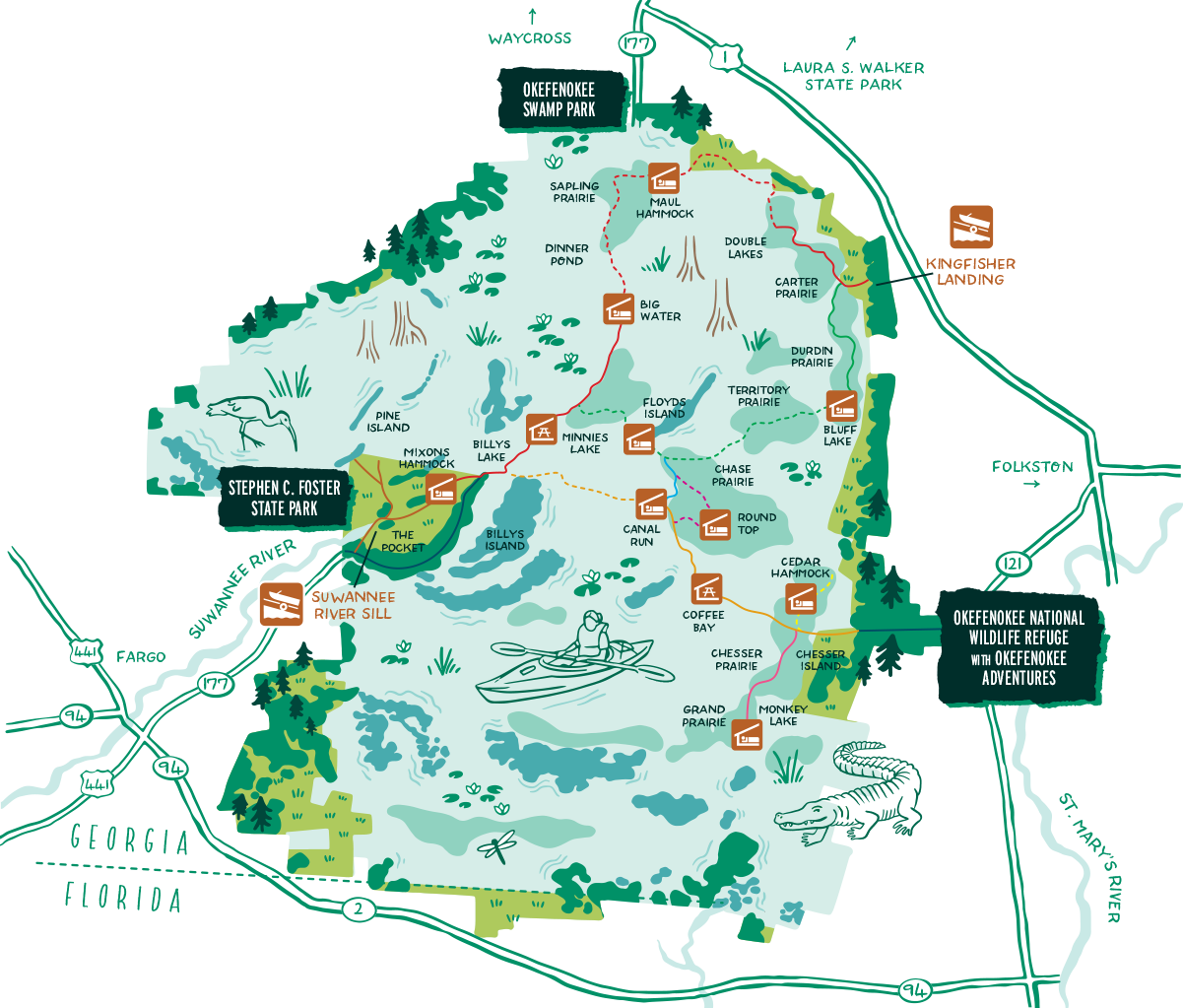
Explore Locations
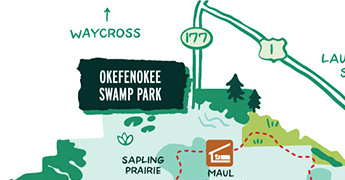
Enjoy a variety of fun activities and a wonderful show-window into the swamp under a forest canopy. Wilderness boardwalks and walkways, guided boat tours along swamp waterways, live wildlife shows and habitats, a pioneer island homestead and railroad tour are just a few of the park highlights.
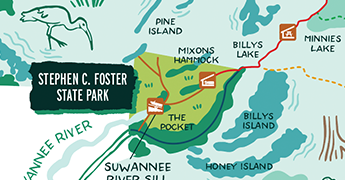
This remote park is a primary entrance to the legendary Okefenokee Swamp. Paddlers and photographers will enjoy breathtaking scenery and abundant wildlife. Stargazers will appreciate the particularly dark sky.
Same-day reservations are recommended for guided boat tours. Ask about our sunset and night tours. Rent canoes, kayaks or Jon boats for further exploration, including a trip to historic Billy’s Island.
Make time for fishing by staying overnight in a cabin or campsite.
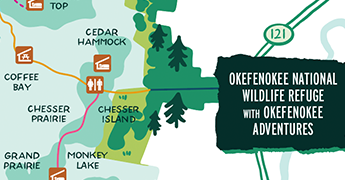
Okefenokee National Wildlife Refuge with Okefenokee Adventures
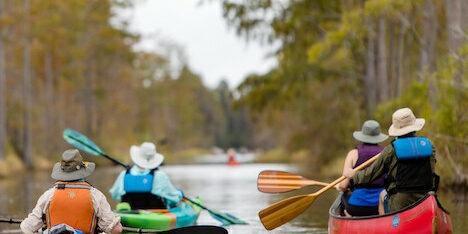
Enjoy exploration and wilderness observation, hiking, driving or biking along our Swamp Island Drive. Stop by our visitor center, take a guided boat tour, or kayak or canoe into our famous swamp prairies through cypress-lined waters, lily pads and grassy islands.
Onsite concession, Okefenokee Adventures, offers canoe, kayak and Jon boat rentals, cafe and gift shop.

At the heart of Southeast Georgia, the historic town of Waycross is a city filled with Southern hospitality and charm with numerous opportunities for dining, lodging and shopping, as well as attractions such as the Historic Downtown district, the Okefenokee Swamp Park, the Southern Forest World Museum, the Okefenokee Heritage Center, and more.
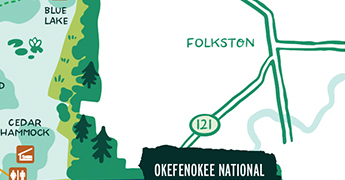
Experience rural South Georgia, with a taste of authentic, small-town charm.
This excellent weekend getaway is complete with beautiful sights, outdoor exploration, and a rich history. Centrally located between Amelia Island, St. Marys, Jacksonville, and Savannah, Charlton County is only a short drive from I-95, making it the ideal place to experience everything South Georgia has to offer.
Get up close and personal with trains by relaxing under the Folkston Funnel, visiting the historical train museum, or even sleeping overnight in a train cart. Immerse yourself in off the beaten path experiences at the Okefenokee Wildlife Refuge. Photograph the overhanging beauty and wildlife or take a step back in time and see how the early swampers dwelled.
Visitor Questionnaire
Tell Us More About you and we can create the best experience.
- Young Children
- Cultural History
- Birdwatching
- 1-2 months from now
- 3-5 months from now
- 6-11 months from now

Use one of the services below to sign in to PBS:
You've just tried to add this video to My List . But first, we need you to sign in to PBS using one of the services below.
You've just tried to add this show to My List . But first, we need you to sign in to PBS using one of the services below.
- Sign in with Google
- Sign in with Facebook
- Sign in with Apple
By creating an account, you acknowledge that PBS may share your information with our member stations and our respective service providers, and that you have read and understand the Privacy Policy and Terms of Use .
Get extended access to 1600+ episodes, binge watch your favorite shows, and stream anytime - online or in the PBS app.
- Become a Member
Already a GPB member?
You may have an unactivated GPB Passport member benefit. Check to see .
You have the maximum of 100 videos in My List.
We can remove the first video in the list to add this one.
You have the maximum of 100 shows in My List.
We can remove the first show in the list to add this one.

Tour the Okefenokee Swamp and interact with swamp experts during this live exploration. More
Travel through the Okefenokee Swamp, witness the power of the mighty alligator, and interact with swamp experts during this live exploration.
Collections
More science and nature shows.

Discover the Magic of Okefenokee Swamp Tours
Imagine yourself exploring a land of mystery, beauty, and unparalleled biodiversity. You’re about to embark on an adventure like no other – an Okefenokee Swamp tour. From the fascinating history to the unique flora and fauna, there’s something for everyone to discover. Let’s delve into the captivating world of the Okefenokee Swamp and provide you with all the information you need to plan the perfect swamp tour.
Title Image: A gorgeous view on a sunset tour of the Okefenokee Swamp—courtesy of Georgia’s own local guides at Okefeenokee & Satilla Expeditions
Key takeaways:
- Experience the breathtaking biodiversity of the Okefenokee Swamp, including 32 species of frogs and a myriad of unique plants.
- Learn about the rich history of the swamp, from its wealthy owners in the 1890s to its fascinating use of prison labor.
- Discover the swamp’s unique ecosystem, including its intriguing adaptations and natural wonders.
Okefenokee Swamp Tours: Your Ultimate Adventure

The Okefenokee Swamp, also known as “the land of trembling earth” to Native Americans, spans over 440,000 acres–roughly the size of Rhode Island. With a history dating back to the 1890s, the swamp has gone through various stages of development, including the harvesting of valuable cypress trees and the construction of a six-mile canal using prison labor.
As you embark on your Okefenokee Swamp tour, you’ll be immersed in an environment unlike any other, characterized by:
- A unique combination of prairie and forest islands.
- A diverse range of wildlife, including 32 species of frogs that indicate water quantity.
- The 2nd most lightning strikes in the US, after Tampa.
- Natural phenomena like droughts, fires, and rains occurring every 5-7 years.
The Amazing Flora of the Okefenokee Swamp
During your tour, you’ll encounter a diverse array of plant life, including:
- Maiden cane: A member of the bamboo family, this plant thrives in the swamp’s unique ecosystem. It is one of the first plants to form when submerged peat surfaces. These small islands grow larger, forming the “trembling earth” and are the keystone to growth of the islands here and their habitats.
- Cypress trees: These deciduous conifers are extremely valuable and rot-resistant, making them ideal for use in construction and other industries. Their unique adaptations, such as flared bases and horizontal root systems, allow them to thrive in the swamp’s soft, mushy soil. Their roots are very strong and intertwined with neighboring trees. So much so that these trees will snap in the high winds of a hurricane, instead of toppling over.
- Spanish moss: A natural air filter, this bromeliad is an epiphyte, meaning it grows on other plants without harming them. Thick layers of Spanish moss indicate that the area has not experienced a fire in over 50 years.
- Red lichen: Found on myrtle trees, red lichen is an indicator of high oxygen levels and air quality. In fact, the deep recesses of this swamp are even designated a Natural Wilderness Area.

The Fauna of the Okefenokee Swamp
Some of the fascinating creatures you may encounter on your tour include:
- Eastern barred owls with their nests and babies.
- Red-shouldered hawks, soaring through the skies.
- Softshell and Snapping turtles.
- Alligators, ranging from small juveniles, to large adults over ten feet long.

The Intriguing History of the Okefenokee Swamp
As you explore the Okefenokee Swamp, you’ll learn about its storied past, which includes:
- Wealthy owners purchasing the land for 25 cents per acre in the 1890s to harvest cypress trees.
- The use of prison labor to dig a six-mile canal for transporting timber to a mill onsite.
- The influence of Spanish and French explorers, who contributed to the naming of Spanish moss.
Natural Phenomena and Unique Features
Your Okefenokee Swamp tour will also reveal the swamp’s fascinating natural phenomena, such as:
The swamp’s unique drainage system, which flows east to west and eventually drains into the Gulf of Mexico via the Suwannee River.
- The importance of the swamp’s water, which is potable due to its acidity and natural rainwater composition. No outside water flows into the Okefenokee.
- The cyclical nature of the swamp’s climate, characterized by drought, fire, and rain every 5-7 years, which helps shape the ecosystem and maintain its delicate balance.

Preparing for Your Swamp Tour
To make the most of your swamp tour experience, keep the following tips in mind:
- Dress appropriately: Wear comfortable clothing and sturdy shoes, as you’ll be navigating potentially wet and uneven terrain.
- Bring bug repellent: Chiggers, common in the swamp, once caused the first automotive recall due to their infestations in car seat padding recommended by Thomas Edison.
- Stay hydrated: While the swamp water is potable, it’s always a good idea to bring your own water supply to stay refreshed during your tour.
Experience the Magic of the Okefenokee Swamp
With its enchanting landscapes, captivating history, and unparalleled biodiversity, an Okefenokee Swamp tour offers a one-of-a-kind adventure. Whether you’re a nature lover, history buff, or simply seeking a unique experience, the Okefenokee Swamp has something for everyone. So grab your gear, gather your friends, and get ready to embark on the journey of a lifetime through the land of trembling earth.
Table: Okefenokee Swamp Tour Highlights
An Okefenokee Swamp tour offers an unforgettable experience that combines history, biodiversity, and natural beauty. Once you’ve explored the wonders of the swamp, don’t miss the opportunity to discover other charming coastal towns in the region , each with its unique attractions and allure. And while you’re in the area, be sure to stop by the Okefenokee Restaurant in Folkston for a taste of authentic Southern cuisine .

Here’s a list of resources to help you plan your Okefenokee Swamp tour and learn more about this unique ecosystem:
- Okefenokee National Wildlife Refuge : The official website of the Okefenokee National Wildlife Refuge offers detailed information about the swamp, its wildlife, and recreational activities.
- Stephen C. Foster State Park : Located within the Okefenokee Swamp, this state park offers boat tours, canoe and kayak rentals, and other recreational activities.
- Okefenokee & Satilla Expeditions : Support the only locally owned and operated Swamper family outfitter in the swamp. Boasting over 1,400 tours under their belt, you can experience an exclusive peek into the swamp’s most secluded and wild areas. Experience Georgia wilderness tours, ranging from paddling to camping into the soul of the Okefenokee. Ready to set off on this adventure? Schedule your tour here.
- Okefenokee Swamp Park : This park offers guided tours, educational programs, and other activities for visitors to the Okefenokee Swamp. Check out their website for tour options, rates, and hours of operation.
- Okefenokee Adventures : This outfitter provides guided tours, canoe and kayak rentals, and other services to help you explore the Okefenokee Swamp.
- Okefenokee Pastimes : This eco-lodge and campground is located near the Okefenokee National Wildlife Refuge and offers guided tours, educational programs, and other activities.
Related Posts

Savannah Bike Tours: Gliding Under Spanish Moss

Wormsloe Plantation: A Step Back in Time

Georgia’s Best Beaches: From Popular to Peaceful
Leave a comment cancel reply.
Your email address will not be published. Required fields are marked *
Save my name, email, and website in this browser for the next time I comment.
National Wildlife Refuges Abound With Gorgeous Wetlands
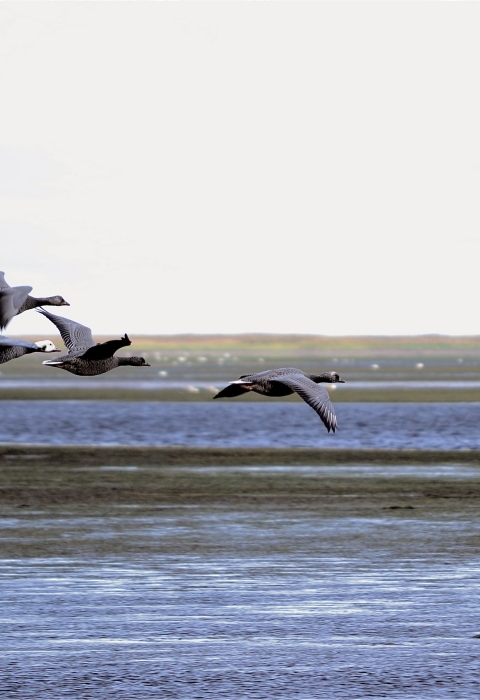
The Ramsar Convention , the oldest modern global intergovernmental environmental agreement, encourages the designation of sites containing representative, rare or unique wetlands, or wetlands that are important for conserving biological diversity. The United States boasts 41 Ramsar sites across the United States totaling over 4.6 million acres. Twenty- three of these sites fall completely or partially within National Wildlife Refuges managed by the U.S. Fish and Wildlife Service.
Here’s a look at the first four U.S. Ramsar sites, dedicated on December 18, 1986 (all National Wildlife Refuges) and what makes them worthy of international recognition!
Ash Meadows National Wildlife Refuge in Nevada
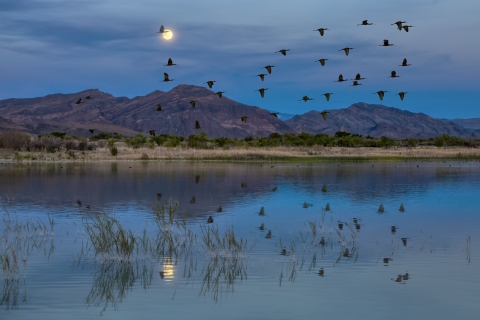
Despite being in the hottest and driest corner of the United States, Ash Meadows National Wildlife Refuge is home to the second greatest concentrations of endemic species in North America. In just under 24,000 acres live 26 species found nowhere else on Earth. That’s because approximately 10,000 years ago, as the climate warmed, aquatic species survived by seeking refuge in receding and fragmenting wetlands. Isolated for millennia, the survivors evolved into new species in separated “ islands of water ” scattered across a sea of desert. Nearly all of Ash Meadows’ endemic species live in or around its 50 springs and seeps.
Ash Meadows’ miraculous wetland endemism is what qualified it as a Wetland of International Importance 35 years ago. At Ash Meadows, the desert springs to life with rare and endemic species of aquatic animals and wildflowers where perennial outflow from springs and a shallow water table support alkali meadows, alkali seeps, and the refuge’s eponymous ash groves. Fourteen federally protected threatened and endangered species and over 100 state protected and priority species live on the refuge. The springs also provide habitat for megafauna like parched desert bighorn sheep. Ash Meadows is a gathering place so bountiful in nature’s diversity it can be easy to forget that it is surrounded on nearly all its sides by one hundred miles of desert.
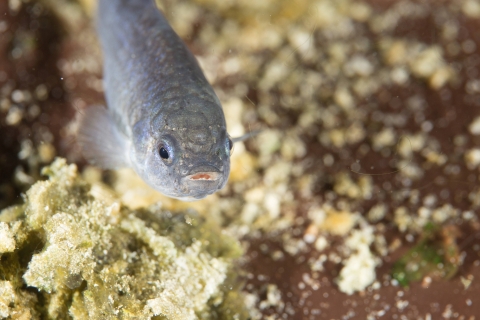
More Site Facts
- Within Ash Meadows’ springs and spring outflows live two varieties of charismatic pupfish, a speckled dace, 10 spring snail species, 2 water bugs, and a rifle beetle.
- The surrounding alkali soils’ proximity to groundwater provide habitat for nine endemic wildflowers and a multitude of other rare ones.
- Spring-fed reservoirs, emergent marshes, and mesquite bosques host over 275 species of birds, many international visitors on layover as they journey along the Pacific Flyway.
Edwin B. Forsythe National Wildlife Refuge in New Jersey
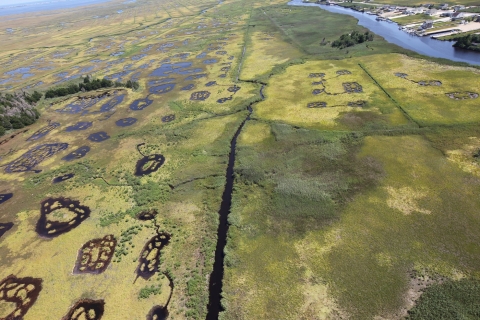
Edwin B. Forsythe National Wildlife Refuge protects more than 47,000 acres of coastal habitat. The refuge is within one of the Atlantic Flyway’s most active flight paths, providing vital rest and refueling habitat to over 200 species of migratory birds, including the threatened or endangered piping plover, least tern, and roseate tern.
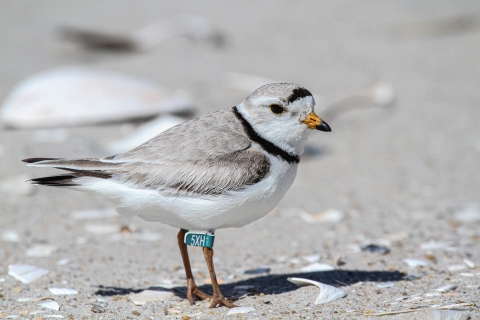
Eighty-two percent of the refuge is wetland. Seventy-eight percent of this wetland habitat is salt marsh salt marsh Salt marshes are found in tidal areas near the coast, where freshwater mixes with saltwater. Learn more about salt marsh , some of the most ecologically productive land on Earth. Salt marshes serve as nurseries for young fish, nesting habitat for coastal songbirds, and feeding grounds for many species of ducks, geese, herons, and egrets. These salt marshes also provide other important benefits including: filtering runoff and excess nutrients to help maintain water quality in coastal communities, absorbing flood waters during storm events, and mitigating the effects of climate change climate change Climate change includes both global warming driven by human-induced emissions of greenhouse gases and the resulting large-scale shifts in weather patterns. Though there have been previous periods of climatic change, since the mid-20th century humans have had an unprecedented impact on Earth's climate system and caused change on a global scale. Learn more about climate change by sequestering and storing carbon.
- The refuge supports rare sea-level fen communities, which in turn support six rare plant species.
- Peregrine falcons and ospreys frequent refuge wetlands and take advantage of the nesting platforms erected for their use.
- Each spring and fall tens of thousands of migrating ducks and geese, wading birds, and shorebirds congregate at the refuge.
Izembek National Wildlife Refuge in Alaska
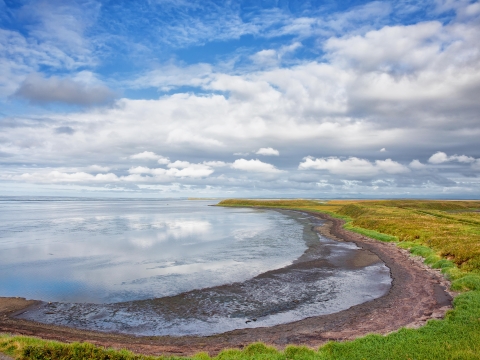
Situated along the Ring of Fire between the Gulf of Alaska and the Bering Sea, Izembek National Wildlife Refuge hosts a stunning diversity of wildlife and cradles the famous Izembek Lagoon. The lagoon’s 150-square mile coastal wetland has one of the world’s largest eelgrass beds and provides a critical stopover for hundreds of thousands of migrating waterfowl to rest and refuel.
Since 1960, the lagoon and its associated state-owned tidal lands have been protected by Alaska as the Izembek State Game Refuge, while the National Wildlife Refuge surrounds the lagoon and protects the coastal uplands.
- People have called this place home for thousands of years, thriving on the coastal bounty. The refuge is on the traditional homelands of the Unangax̂ people. The word for “Alaska” comes from the Unangax̂ word for the Alaska Peninsula, Alasxix, where Izembek is located.
- Almost the entire population of Pacific black brant (150,000 birds) stop in the lagoon on their migration from the high Arctic. Long distance fliers to the west coast of North America, they can cover a trans-Pacific route from Izembek to Baja flying over 3,000 miles non-stop in around 55 hours. Izembek’s eelgrass is the superfood, rich in protein and nutrients, that helps power their incredible journey.
- Izembek’s extensive wetlands provide shelter and nourishment for marine mammals such as sea otters, seals, Steller’s sea lions, and many species of fish — including four species of Pacific salmon as they migrate to and from the refuge’s freshwater streams.
Okefenokee National Wildlife Refuge in Georgia
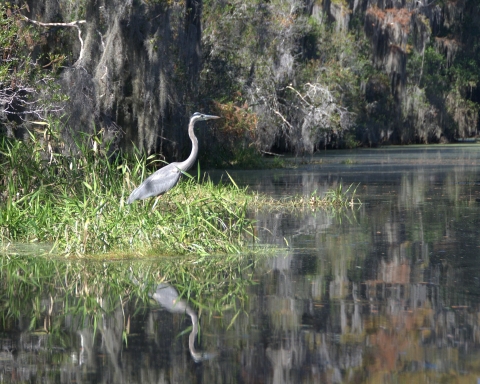
Okefenokee National Wildlife Refuge , on the Atlantic and Gulf Coastal Plains of the southeastern United States, protects the world-renowned Okefenokee Swamp, an exceptional example of the southern yellow pine forests that was once the most extensive forest type in the United States. The diversity and distribution of 21 wetland and upland habitats at Okefenokee support over 1,270 flora and vertebrate fauna species, in addition to thousands of invertebrate species.
Okefenokee Swamp is the most complete, large freshwater wetland ecosystem remaining on the North American Coastal Plain and the largest blackwater wetland ecosystem in North America. It is world renowned for its biological diversity, particularly the range of amphibian and reptile species and the high number of regional endemic species. These species are adapted to the water and fire regimes that characterize each of Okefenokee’s many habitat types.
The refuge spans 407,000 acres, protecting approximately 93 percent of the wetlands that comprise the Okefenokee Swamp, and sees over 600,000 visitors annually, with 10 percent of the visitation represented by international guests from over 46 countries.
- Okefenokee Refuge is a proposed World Heritage Site.
- In 2012, National Geographic magazine recognized the Okefenokee Swamp as one of the top 100 Most Beautiful Places on Earth.
- The swamp is world renowned for its amphibian populations that are bio-indicators of global health.
Explore More: Take a virtual tour of all U.S. Ramsar sites
Special thanks to contributors to this article:
- Ash Meadows: Adamas Weitzenfeld, Visitor Services Specialist
- Edwin B Forsythe: The National Wetlands Inventory Program and Ramsar
- Izembek: Lisa Hupp, Communications Coordinator
- Okefenokee: Susan Heisey, Supervisory Refuge Ranger
NOTE: some of the links go to non federal government websites. This does not constitute an endorsement of any products or services offered there.
Latest Stories
You are exiting the U.S. Fish and Wildlife Service website
You are being directed to
We do not guarantee that the websites we link to comply with Section 508 (Accessibility Requirements) of the Rehabilitation Act. Links also do not constitute endorsement, recommendation, or favoring by the U.S. Fish and Wildlife Service.
- Articles & Media
- Browse by Topic
- Browse Collections
- Browse Georgia Standards
- Exhibitions
Arts & Culture
Business & Economy
Counties, Cities & Neighborhoods
Geography & Environment
Government & Politics
History & Archaeology
Science & Medicine
Sports & Outdoor Recreation

Frankie Welch’s Americana
Fashion and politics from Georgia-born designer Frankie Welch

Art Across Georgia
Take a virtual tour of Georgia's museums and galleries
Recently Added

City Page: Savannah
Georgia’s State Art Collection
Georgia Studies
Georgia, My State
Human History of the Okefenokee Swamp
The Okefenokee Swamp covers nearly 700 square miles, almost all of which is in Georgia. It has a long history as a wilderness, a public common, and a refuge. Since 1937 most of the Okefenokee has been a National Wildlife Refuge. It was designated a National Wilderness Area in 1974.
Indigenous Communities
Indigenous peoples occupied the Okefenokee during the late Archaic , Woodland , and Mississippian periods of Georgia prehistory. The major occupations were during the Weeden Island and Savannah periods, around A.D. 500 and 1200. Sand mounds were constructed in the swamp during this period.
Spanish records between 1602 and 1768 refer to Okefenokee as Laguna de Oconi (Lake Oconi). At least two Timucuan villages and Spanish missions were located in or near the swamp between 1620 and 1656. William Bartram ’s Creek legend, which tells the story of princesses of the sun on an island in the center of the swamp, is probably rooted in stories of the Timucuan settlements.
The Okefenokee was a Creek hunting ground in the late eighteenth and early nineteenth centuries. B riefly in 1836 and for most of 1838 the Second Seminole War in Florida extended into the Okefenokee. Roads and forts were built around the perimeter of the swamp, and Georgia militia and U.S. army troops patrolled intensively. They burned down a Seminole village on an island that they subsequently renamed Floyds Island, for Charles Rinaldo Floyd. In response to this violence, the Seminole began to leave the swamp in 1838 , but skirmishes continued to occur along the Georgia-Florida boundary as late as 1840.
White Settlement
A few white families settled on the southeastern edge of the Okefenokee as early as 1805. Settlers moved into the areas east, north, and west of the swamp after the land lottery of 1820. These pioneers herded cattle, raised hogs , hunted and fished, and cultivated small corn patches and gardens. They lived in log cabins. They occasionally visited Traders Hill or Centre Village, trading hides, jerky, and pelts for salt, ammunition, trinkets, and entertainment. A few families moved onto islands in the swamp during the 1850s. The self-sufficient lifestyle of these settlers largely continued until the early twentieth century.
As the area industrialized in the late nineteenth and early twentieth centuries, the lives of residents, known as swampers, gradually changed. Given their knowledge of the landscape and local ecology, swamp dwellers served as early guides for various surveyors. Some found work in expanding industries, and others sold their land to large lumber companies. As historian Megan Kate Nelson noted, “for some Swamper families, hard cash was irresistible. Their abandonment of their Okefenokee homes was often rooted in a need for money in addition to a conviction that they could either move to another part of the swamp or continue to exercise their hunting and heading rights within the Okefenokee.”
Industrial Development
Sailing vessels visited Traders Hill, fewer than ten miles outside the Okefenokee, by the first decade of the nineteenth century, and steamboats regularly traveled the St. Marys River by the 1830s. Outside of these developments, there was little change in the Okefenokee landscape or livelihood until the railroads reached the rim of the great swamp in the 1860s.
The Atlantic and Gulf Railroad from Savannah was built a few miles north of the Okefenokee by the start of the Civil War (1861-65). Another railroad, from Brunswick to Albany , passed north of the swamp in 1870. With the railroads came sawmills and turpentine stills, store-bought goods, circuses , and new people. A line connected Waycross and Jacksonville, Florida, in 1881, passing within less than a mile of the eastern edge of the swamp. A railroad from Valdosta to Jacksonville was completed in 1898, closing the ring of railroad tracks around the swamp. Industrialization brought jobs at sawmills, turpentine stills, and on the railroads. Steam transformed both the Okefenokee culture and the landscape after 1880. By 1900 the old-growth longleaf pine forest that encircled the swamp was a forest of stumps.
The Georgia legislature in 1889 authorized Governor John B. Gordon to sell the Okefenokee property. The Suwanee Canal Company purchased the property on January 1, 1891. The company attempted to drain the swamp from 1891 until 1893. They built a sawmill and purchased steamboats and steam logging equipment in an effort to raise money by harvesting the cypress timber. Both ventures collapsed in 1897. In 1899 the property was sold to the family of Captain Henry Jackson of Atlanta , the canal company’s former president. Charles Hebard and his sons purchased the Jackson property in 1901.

Image from Timothy J
Learning from the mistakes of the Suwanee Canal Company, the Hebard Lumber Company carefully studied the timber of the swamp and decided to employ railroads to harvest cypress. They leased the property to the Hebard Cypress Company, which built a large sawmill near Waycross and constructed a railroad to the northwestern rim of the swamp in 1909-10. Over the next fifteen years the company systematically built railroads across the swamp and logged the cypress trees of the northern and western Okefenokee.
Other companies, especially the Americus Manufacturing Company, conducted railroad logging operations in the swamp between 1910 and 1926. The big companies ceased operations in 1926-27. Individuals and small companies logged the remaining stands of cypress and pine during the late 1920s; Johnson and Sons Lumber Company may have logged as late as 1942.
Preservation Efforts
Daniel Hebard, the son of the Hebard Lumber Company’s founder, built a hunting cabin in the hammock on Floyds Island in 1925. Family and friends camped on the island during the following decade, usually hunting ducks. A caretaker named Billy Spaulding lived in a hut on the island.
During this period writers and naturalists were also permitted to camp in the cabin on Floyds Island Hammock. Many articles extolling the wonders of the Okefenokee wilderness were published in newspapers, magazines, and books. A number of writers urged that the swamp be purchased as a refuge.
The Okefenokee Society was organized in 1918 in Waycross. Members of the society petitioned the federal government to purchase the Hebard property as a biological preserve, but the society died with its founder, J. F. Wilson, in 1921. The Georgia Society of Naturalists took up the crusade in 1929. Their efforts, supported by other organizations and individuals.
Georgia Coastal Flatwoods Upland Game Project
While conservation organizations promoted the purchase of the Hebard property as a refuge, other development plans were afoot. Some organizations promoted schemes to build a ship canal across the swamp; others pushed for the construction of a scenic highway. The federal government purchased about 40,000 acres of cut-over and burned-over lands on the northeast side of the swamp in 1935. Workers with the Georgia Coastal Flatwoods Upland Game Project planted trees and grass and developed parks. The work was primarily intended to produce jobs through the federal Works Progress Administration program, part of U.S. president Franklin D. Roosevelt ’s New Deal initiative. The federal government turned the project over to the state of Georgia in 1938 and sold the land to the state much later, probably in 1955. Dixon Memorial Forest Wildlife Management Area and two state parks , Laura S. Walker State Park and Okefenokee Swamp Park, were developed on this tract.
Okefenokee Wildlife Refuge
In 1937 the federal government purchased the Hebard Lumber Company property, and Roosevelt created the Okefenokee Wildlife Refuge (now the Okefenokee National Wildlife Refuge) by executive order. An all-Black unit of the Civilian Conservation Corps was transferred to the refuge, and between 1937 and 1941 they developed facilities there, which are still in use today. Designating the Okefenokee a wildlife refuge preserved the swamp but drove out its residents. Swamp dwellers were told they could no longer kill bears and wildcats in order to protect their livestock. The residents found it impossible to support themselves, and over time they moved away. All residents were likely gone by 1958. The size of the refuge has increased over the years. In 1937 the government purchased 292,979 additional acres. Today the refuge comprises 396,000 acres.
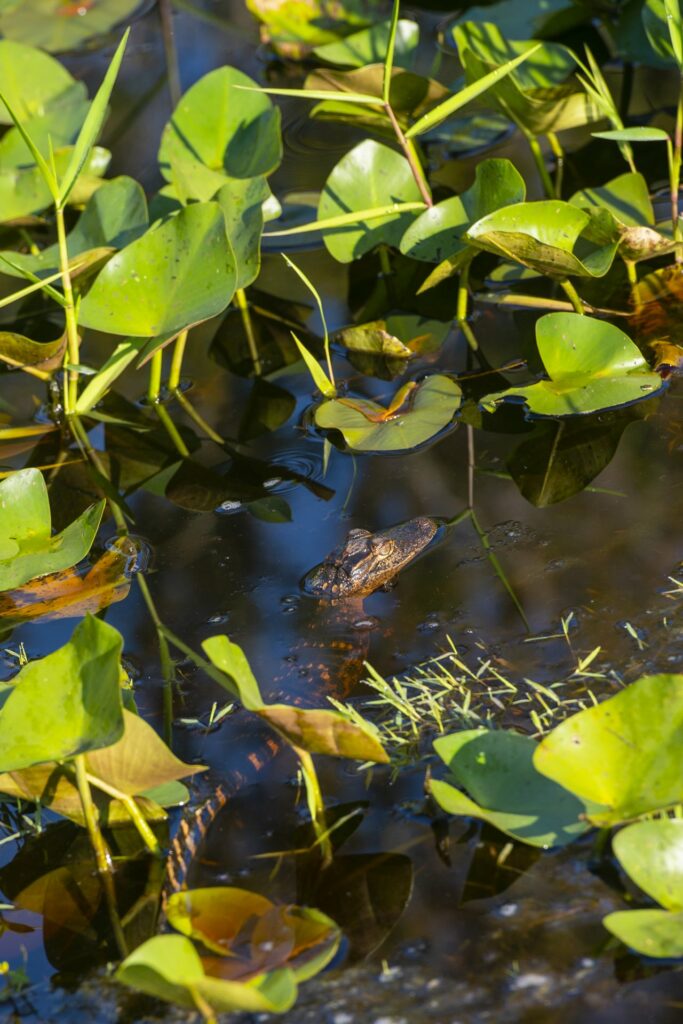
Courtesy of Explore Georgia .
For the first several decades the staff at the Okefenokee National Wildlife Refuge devoted much of its time to maintaining roads and facilities and protecting wildlife from poachers. Since the 1950s the U.S. Fish and Wildlife Service has focused on managing the habitat for wildlife through fire management and by protecting and fostering endangered and threatened wildlife species . Recreation and environmental education have also become more important functions at the refuge. Development of the Suwannee Canal Recreation Area, on the eastern edge of the swamp, began in the mid-1960s.

Courtesy of U.S. Fish and Wildlife Service
Fluctuations of water levels, even minute changes, have a significant effect on the Okefenokee ecosystem. After the drought and wildfires of 1954-55, the federal government constructed an earthen dam, the Suwannee River Sill, on the western side of the swamp to maintain water levels during drought. It was not effective. Plans to breach the sill are being implemented.
Recent Developments
Camp Stephen Foster was established in 1948 as a private concession within the refuge. The state of Georgia acquired the concession as Stephen C. Foster State Park in 1954. In 1974, 353,981 acres of the refuge were included in the National Wilderness System. A Wilderness Canoe Trail system was instituted in the 1970s. The Ramsar Convention on Wetlands, an international convention that promotes the preservation of waterfowl habitat, recognized the Okefenokee as a wetland of international importance in 1986.
On April 16, 2007, a downed power line southwest of Waycross started the Sweat Farm Road fire. On May 5, two lightning strikes on Bugaboo Island in the Okefenokee Swamp sparked a fire that merged with the Sweat Farm Road blaze to become the largest wildfire in Georgia’s history, and among the largest in Florida’s history. The fire, which has been called the Bugaboo Scrub Fire and the Georgia Bay Complex Fire, burned more than 564,000 acres in Georgia and Florida, shut down interstate highways 10 and 75, and, in the end, cost more than $80,000,000 in lost timber and reforesting costs. The fire was maintained by drought conditions and forty smaller fires across the region, which were mostly started by careless burning and arson. The fire was finally contained in late June 2007. There were no casualties, but nine homes were lost.

Photograph from FEMA
On April 28, 2011, another lightning strike in the Okefenokee Swamp ignited a massive wildfire called the Honey Prairie Fire. The fire burned more than 300,000 acres in the swamp over the course of three months.
Cite this Article
Trowell, C. "Human History of the Okefenokee Swamp." New Georgia Encyclopedia, last modified Feb 23, 2022. https://www.georgiaencyclopedia.org/articles/geography-environment/human-history-of-the-okefenokee-swamp/
Trowell, C. T. (2002). Human History of the Okefenokee Swamp. In New Georgia Encyclopedia . Retrieved Feb 23, 2022, from https://www.georgiaencyclopedia.org/articles/geography-environment/human-history-of-the-okefenokee-swamp/
Trowell, C. "Human History of the Okefenokee Swamp." New Georgia Encyclopedia , 20 September 2002, https://www.georgiaencyclopedia.org/articles/geography-environment/human-history-of-the-okefenokee-swamp/.
Article Feedback
- General feedback
- Content feedback
- Suggest an article
- Website issue
- Suggestions or comments *
- First name *
- Last name *
- Title of article *
- Description of error *
- Correction to be made *
- Your source(s) for the correct information *
- Suggested topic *
- Brief description and information about the topic's significance for Georgia *
- Sources for information about this topic *
- Title of article or page where error occurred *
- Description of error or error message *
Share this Article

The Okefenokee Swamp covers nearly 700 square miles, almost all of which is in Georgia. It has a long history as a wilderness, a public…
Share this Snippet
Featured content.

James Oglethorpe

Harriet Powers
Berckmans Nursery
Glascock County
James Osgood Andrew
John C. Inscoe
Updated recently.
Auburn Avenue Research Library on African American Culture and History
Grains and Corn
Classical Music in Atlanta
Augusta Jane Evans Wilson
A more perfect union.
The New Georgia Encyclopedia is supported by funding from A More Perfect Union, a special initiative of the National Endowment for the Humanities.
Okefenokee Swamp Tools
- Info Details
- Citation Terms of Use
Tools used by nineteenth-century inhabitants of the Okefenokee Swamp.
Courtesy of Georgia Department of Economic Development .
The New Georgia Encyclopedia does not hold the copyright for this media resource and can neither grant nor deny permission to republish or reproduce the image online or in print. Requests for permission to publish or reproduce the resource may need to be submitted to the Georgia Department of Economic Development .

Okefenokee Swamp
Cypress swamps, winding waterways, and floating peat mats are a major part of the Okefenokee's habitat mosaic.
View on source site
The New Georgia Encyclopedia does not hold the copyright for this media resource and can neither grant nor deny permission to republish or reproduce the image online or in print. All requests for permission to publish or reproduce the resource must be submitted to the rights holder.

The swamp's distinctive ecosystem is the subject of legends, tall tales, and personal experience narratives about bears, alligators, and encounters with the natural world.
Courtesy of Explore Georgia , Photograph by Geoff L. Johnson.
The New Georgia Encyclopedia does not hold the copyright for this media resource and can neither grant nor deny permission to republish or reproduce the image online or in print. Requests for permission to publish or reproduce the resource may need to be submitted to Explore Georgia .
Honey Prairie Fire
The Honey Prairie Fire, a massive wildfire in the Okefenokee Swamp, is pictured on April 30, 2011, two days after a lightning strike in the swamp ignited the blaze. The fire burned more than 300,000 acres in the swamp over the next three months.

Traditional poled boats, suited to maneuvering in tight water, were used in the days of alligator hunting and frog gigging. The swamp is now a federal wildlife refuge.
Courtesy of Zach S. Henderson Library, Georgia Southern University , Delma E. Presley Collection of South Georgia History and Culture.
The New Georgia Encyclopedia does not hold the copyright for this media resource and can neither grant nor deny permission to republish or reproduce the image online or in print. Requests for permission to publish or reproduce the resource should be submitted to the Zach S. Henderson Library at Georgia Southern University .

Several local farmers travel through the Okefenokee Swamp in Ware County, circa 1900. At more than 700 square miles, the Okefenokee is the largest swamp in North America.
Courtesy of Georgia Archives , Vanishing Georgia, # war012.
View on partner site
The New Georgia Encyclopedia does not hold the copyright for this media resource and can neither grant nor deny permission to republish or reproduce the image online or in print. Requests for permission to publish or reproduce the resource should be submitted to the Georgia Archives .
Bugaboo Scrub Fire
In 2007 lightning strikes caused the largest wildfire in Georgia's history, which burned more than 564,000 acres. Known as the Bugaboo Scrub Fire or the Georgia Bay Complex Fire, it took almost two months to put out.


Amelia Island Kayak Excursions
Where Kayaking Fun Begins!
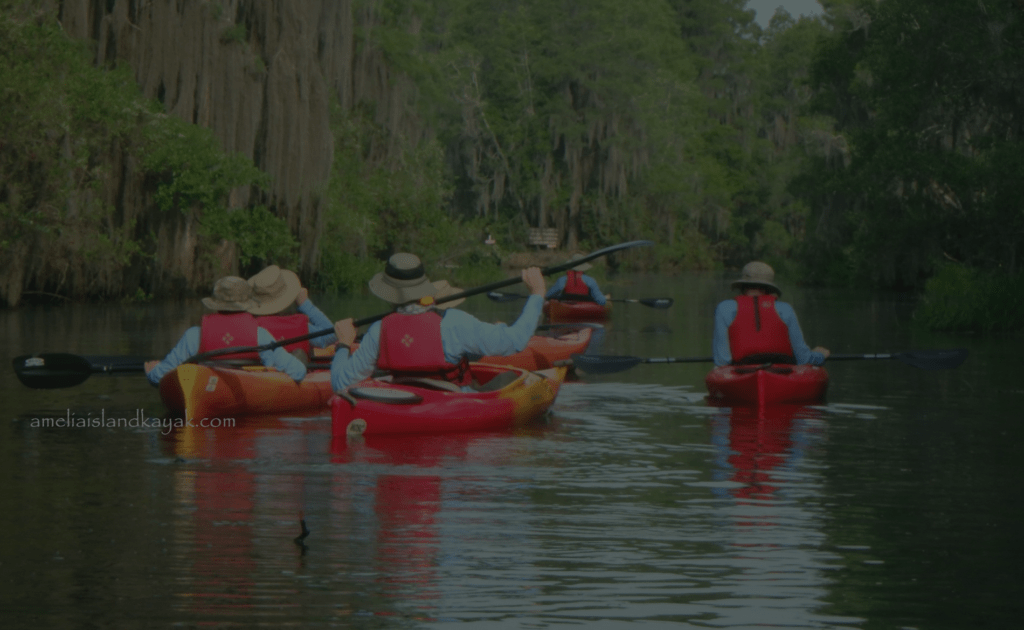
This tour is considered a day trip, consisting of a 5-hour paddle with a 2-hour round trip travel time from Amelia Island, Florida, or our guests may meet our guide on site.
Includes park admission. Two-person minimum. Lunch may be purchased on-site and/or packed to take along on tour. Shorter tours are available and can be customized.
3 or more Paddlers
Okefenokee photo gallery.

Madison Tipton: Kayak Guide
“I was also nominated and served at Vice President and President for the NorthEast Florida Master Naturalist Chapter. It was an honor for me to have the opportunity to meet the man who started it all, Dr. Mary Main!”
Aaron Bullington: Kayak Guide – Florida Master Naturalist
“Anyone can float down or camp on a river – but discovering how to live life while enjoying the passion of adventure, taking risks, and experiencing peace is a life well lived.” -the Saltwater Cowboy

Everytime I am out on the water, it feels as if time stands still, and there is always something new to discover. Hope to see you out on the water!
Favorite quotes: “Dream Big and Celebrate Always” & “Life is a Special Occasion”!
Buy Your Gift Cards Here
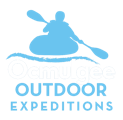
- Adventure with us into the Okefenokee National Wildlife Refuge!
Okefenokee Overnight Adventure
Quick Details
- Calendar Duration: 2 Nights, 3 Days
WHEN: Friday, March 22nd through Sunday, March 24th. Custom dates available by request.
WHERE: Okefenokee National Wildlife Refuge. To begin at Suwanee Canal Recreation Area.
Adventure With us to The Okefenokee National Wildlife Refuge!
On this 2 night, 3 day trip into the Okefenokee Swamp, the “Land of the Trembling Earth,” we will explore the natural beauty and abundance of wildlife found in this unique wilderness area. The refuge also boasts some of the darkest skies in the Southeast! After a magnificent sunset, gaze up at the stars and spot the Milky Way among the breathtaking night sky.
Our guides create a safe, informative, and enjoyable experience. Platform camping is how it’s done in the swamp, offering a front stage view and continuous opportunities for flora and fauna sightings. Over the course of the weekend delicious meals will be prepared for you. In addition to a boat, paddle(s) and personal flotation device(s), a tent will also be provided. Plan to bring your own sleeping pad and bag, but we can also provide that for you – just let us know.
If you’d like to head down the day before to avoid making an extra-early drive, make a reservation at Okefenokee Pastimes Cabins and Campground and meet us in the evening for dinner and breakfast in the morning! You will have access to the tent you will use on the trip if you select a tent site.
To inquire about using a personal vessel on the trip, please call before booking to discuss further. 478-733-3386
Platform reservation cost ($15/person per night) is included in the overall trip cost.
Related Activities
- The most unique way to experience the Ocmulgee
- Hour Glass 2 Hours
Full Moon Float
One of our most popular trips! Experience the Ocmulgee under a full moon and be amazed.
- Our premium guided tour
Far From the Madding Crowd Tour
Winding through a wooded corridor, the Upper Ocmulgee is home to bald eagles, blue herons, and slider turtles. Very little signs remain of the many mills that harnessed the river’s
Boat Shuttle Service
Leave the transportation up to us! We will haul you up the river on our bus for your river floats booked online with Ocmulgee Outdoor Expeditions.

Field Trips
At okefenokee swamp park.

OSP Field Trips located at:
Okefenokee Swamp Park
5700 Okefenokee Swamp Park Rd Waycross, Georgia 31503
Choose a toggle below for more information and to reserve a field trip for your group.
SCHOOL GROUPS: Okefenokee RESA Public School
Reservations for okefenokee regional education service agency (resa) area school districts (atkinson, bacon, brantley, camden, charlton, clinch, coffee, pierce, and ware counties) must be made by filling out the form below..
We consider school groups to be 25 or more paid students/adults. Advance reservations are required and must be made at least 4 weeks prior to the trip date – the sooner the better. Our peak season is March, April, and May, so reservations may need to be made sooner if you are planning your trip for those times. Your reservation date is NOT secured until you receive a confirmation email from us.

- Name of School or Group
- School’s or Group’s address
- 2 Contact Phone Numbers
- 1st, 2nd, & 3rd Choice Preferred Dates
- Time of Arrival
- Time of departure
- Approximate number of students, teachers, & parents/chaperones
- Transportation type
- If you will be bringing and eating lunch while at the park or if you plan to utilize our Snack Shack options.
- Your selection of Field Trip Options. View the current options here: Field Trip Rotation Descriptions
If chaperones/parents will be attending with your group and wish to participate in the field trip or tour, we must have an accurate count prior to your arrival and their payment should be included with your total payment for the trip. Chaperones who arrive at the park who were not included in the total count may not be able to participate in all field trip activities.
***(Please bring your tax exempt form on the day of your trip.)***
- Students (Middle School and Under): $13.00
- Adults (High School and Over): $15.00
- Adults (if paid individually on the day of the trip): $16.00
- Students (Middle School and Under): $19.00
- Adults (High School and Over): $20.00
- Adults (if paid individually on the day of the trip): $21.00
SCHOOL GROUPS: Non-Okefenokee RESA School
Reserve a school field trip:, reservations for school groups of 25 or more must be made by filling out the form below..
You will need the following information when completing the School Field Trip form below:
- Your selection of Field Trip Options. View the current options here: Field Trip Rotation Descriptions . Please note pricing changes for the 2022-2023 school year below.
***(If you are tax exempt, please bring your tax exempt form on the day of your trip.)***
- Students (Middle School and Under): $18.00
- Adults (High School and Over): $19.00
- Adults (if paid individually on the day of the trip): $20.00
- Each additional program (excluding the boat tour) beyond the first three is an additional $1/person/program.
- Students (Middle School and Under): $22.00
- Adults (High School and Over): $23.00
- Adults (if paid individually on the day of the trip): $24.00
- Each additional program beyond the first three is an additional $1/person/program. (example: Water Excursion, Train Exploration, Nature Show, and Living History would cost $23.00 per student and $24.00 per adult.)
PRIVATE TOURS
Reserve a private tour:, reservations for private group tours of 25 or more must be made by filling out the form below..
We consider private group tours to be 25 or more paid participants. Advance reservations are required and must be made at least 4 weeks prior to the trip date – the sooner the better. Our peak season is March, April, and May, so reservations may need to be made sooner if you are planning your trip for those times. Your reservation date is NOT secured until you receive a confirmation email from us.
You will need the following information when completing the Private Group Tour form below:
- Name of Group
- Approximate number of participants
*(If you are tax exempt, please bring your tax exempt form on the day of your trip.)*
TOUR OPERATOR GROUPS
Reserve a tour operator visit:, reservations for tour operator groups of 25 or more must be made by filling out the form below. the programming options for a tour group are limited to a water excursion, train ride, and nature show..
We consider tour operator groups to be 25 or more paid participants. Advance reservations are required and must be made at least 4 weeks prior to the trip date – the sooner the better. Our peak season is March, April, and May, so reservations may need to be made sooner if you are planning your trip for those times. Your reservation date is NOT secured until you receive a confirmation email from us.
You will need the following information when completing the Tour Operator Field Trip form below:
- Approximate number of group participants
- Each additional program beyond the first three is an additional $1/person/program. (example: Water Excursion, Train Exploration, Nature Show, and Living History would cost $22.00 per student and $24.00 per adult.)
Simple Guidelines:
If you are bringing a school group or a group of children, we require one chaperon per ten children. Those chaperones will be complimentary. Any chaperones who attend that are not complimentary will need to give their field trip/tour fee to the group leader or organizer ahead of time to include in the total payment. Chaperones who wait to make their payment until they arrive at the park are not guaranteed to complete all field trip activities. Escort and driver are complimentary. Please allow 3 to 4 hours to see and complete all activities at the park. We will create the schedule for you so you’ll know who needs to be where and when. Once you receive your confirmation letter please read it carefully. If something is not correct, contact us as soon as possible. Should you need to cancel, please allow us at least one day advance notice. Please note that we will be contacting you using the email address that is collected on the Field Trip Reservation Form.
Payment: We do not require a deposit; however, payment is due on the day you arrive and must be paid with one payment transaction.
Arrival: It is extremely important that your group arrives at the Okefenokee Swamp Park at least 30 minutes prior to the start time for your field trip . We cannot guarantee that we will be able to provide your full field trip selections if you are late.
For Georgia Schools: Tax Exempt Notice: You must pay with a school check and provide a Sales and Use Tax Certificate of Exemption when you come. Failure to do this will result in the 8% being added to your total. You must bring this form EVERY time you come, no exceptions. Parents or others not covered in the one to ten chaperones will have to pay separately and pay tax, unless you include them in the school check. Prices will be given when you set up the visit.
Can groups visit the gift shop?
The park has one gift shop available to guests. We ask that teachers only allow 25 students at a time and as soon as purchases are made to exit to make room for others. Prices range from $1.99 and up.
How much time will our group need?
Depending upon the size of the group, you will need from 4 to 6 hours.
Do you have educational materials for teachers?
Please contact Katie Antczak at [email protected] to arrange access to educational materials.
The school will provide lunch, but where can we eat?
We have picnic areas, one covered (with restroom facilities available), on a first-come, first-served basis. We do not charge for these facilities, but ask that you clean up after yourself.
Are there lunch options available at the park?
Lunch may be available from our Snack Shack for an additional cost. Please contact William Baumler at [email protected] to make lunch arrangements at least 2 weeks prior to your field trip date.
What if it rains?
Unless there is a severe weather event, all programs will continue as normal. Most of the field trip/tour activities are outdoors, so prepare for the weather. If the weather forecast predicts heavy rain, you may reschedule your trip/tour, but we need at least a 24-hr advanced notice. Sorry – no refunds for weather conditions or insects!
Will we need sunscreen or bug spray?
Most of the time you will need one or the other, if not both. Some months like October thru February, you’re safe, but bring them just in case! It’s better to be safe than sorry.
Is admission for chaperones free?
In order for things to go smoothly for you and the park, we request at least one chaperon per ten children. We will extend complimentary passes to the one chaperone per ten children. Chaperons will be with their kids at ALL times (in the park and gift shop) to ensure respectful behavior to our animals and other guests.
Is this tour on our own or will we have a guide?
How much of your tour or field trip is guided is dependent upon your selections for field trip rotations. For example, if you choose the “Treasures of the Okefenokee” science program, you will have a naturalist or educator with you during the program, but you may have to walk to your next program (Water Excursion, Train Experience, Eye on Nature Show, etc.) on your own. We will take the guess-work out of “where do I need to be and when” by scheduling your group for the rotations that you have selected. It will include times for the gift shop, meals and bathroom breaks. If you have any special needs we will accommodate you the best way we can.
Can we take a boat excursion?
Water excursions via boat are dependent upon water levels and guide availability. There are times when we cannot take a large group due to low water which prevents us from taking the maximum number of persons per boat. Group boat excursion length is approximately 20 minutes.
How do we reserve for our group?
To reserve your field trip or tour, please fill out the form and refer to the information found here .
SUPPORT THE OKEFENOKEE
The OSPrey Society are very important friends of the OSP who generously invest in the organization to support the strategic plan, provide critical resources for needed projects and underwrite educational programs. All donations to the OSP help us to inspire our guests and community to conserve and protect our beloved Okefenokee.

- 5700 Okefenokee Swamp Park Rd Waycross, Georgia 31503 Directions
HOURS OF OPERATION:
Monday – Sunday 9:00 am to 5:00 pm
*Tour availability can vary with large groups arriving at the park. Please check availability before arriving.
Okefenokee Swamp Park will remain open for all advertised evening events.
- (912) 283-0583
- [email protected]
Group Reservations: (912) 283-0583 or email [email protected]

Okefenokee Adventures
- 4159 Suwannee Canal Rd Folkston, GA 31537 Directions
Hours of Operation:
7:30am – 6:30pm (Mar – Oct)
7:30am – 4:30pm (Nov – Feb) Click here for closures/more info
( 912 ) 496-7156
- levi.welling @okeswamp.org
- Group Reservations: (912) 496-7156
We respect your privacy.
Our mission is to provide visitor access and interpretive education that inspires conservation advocacy for the Okefenokee Swamp.
© Copyright 2021 - 2023 | Okefenokee Swamp Park & Adventures | All Rights Reserved | Website by Hamsa Design
View our Terms & Conditions and our Privacy Policy

IMAGES
VIDEO
COMMENTS
Tour the Okefenokee Swamp and interact with swamp experts during this live exploration. Support Materials. ... This virtual field trip takes students on a journey throughout the state of Georgia, guiding them through twelve of the state's physical features and explaining the relative location of each, as well as their environmental ...
Book your adventure today at one of our two locations. Okefenokee Swamp Park offers Boat Tours, Train Rides, Interactive Exhibits & Animal Encounters. Okefenokee Adventures, located within the Okefenokee National Wildlife Refuge, offers Guided Boat Tours, Kayaking, Hiking Trails and Camping Excursions. Come visit us for an adventure of a lifetime!
Guided Boat & Canoe Swamp Tours at Okefenokee Adventures. Swamp Tours and Extended Excursions with our knowledgeable and experienced guides ... Okefenokee Swamp Park will remain open for all advertised evening events. (912) 283-0583. [email protected]. Group Reservations: (912) 283-0583 or email [email protected]. Okefenokee Adventures ...
Tour the Okefenokee Swamp Park in Waycross, Georgia, in this virtual reality/360 video experience.View all of our VR|AR resources at https://www.gpb.org/educ...
Available daily. $70 per person. 9:30am - 11:30am. Reservations MUST be made at least 48 hours in advance. *Train ride and nature show are included in your 2 hour boat tour price. Book Online. Golden Hour Tours - 2 hour. Experience the enchantment of Okefenokee Swamp Park's waterways after sundown, delving into the mysteries of the ...
Photos of flora and fauna found in the Okefenokee Swamp Park near Waycross, Georgia, and in the Okefenokee National Wildlife Refuge at its entrances near Fol...
Experience the Okefenokee Swamp's Owls Nest Lookout Tower in 360/virtual reality. Located in Folkston, Georgia, in the Okefenokee National Wildlife Refuge, t...
The Auto Tour Route, also known as the Swamp Island Drive at the Okefenokee National Wildlife Refuge, is a 7.2-mile paved road, which can be used by cars, bikes and walkers. This scenic route is a great way to experience the beauty of the refuge in a comfortable, stress-free way. The Swamp Island Drive provides access to several hiking trails ...
Tour the Okefenokee Swamp and interact with swamp experts during this live exploration. More More. Travel through the Okefenokee Swamp, witness the power of the mighty alligator, and interact with swamp experts during this live exploration.
December 2, 2023. Imagine yourself exploring a land of mystery, beauty, and unparalleled biodiversity. You're about to embark on an adventure like no other - an Okefenokee Swamp tour. From the fascinating history to the unique flora and fauna, there's something for everyone to discover. Let's delve into the captivating world of the ...
The wonderland of the Okefenokee is a significant part of America's heritage, a beautifully preserved segment of what was here when America began. Located in the Okefenokee National Wildlife Refuge, the Okefenokee Swamp Park is a convenient point of entry and a magnificent show-window for this natural wonderland. Reflective waters mirroring the overhanging beauty lead to all points in this ...
Okefenokee & Satilla Expeditions is local family owned and operated and based out of our home county, Ware County, Georgia! We are your source for amazing guided tours in the incredible Okefenokee Swamp and the beautiful Satilla River. We provide Naturalist-guided ecology and history day tours, camping expeditions, rentals, and shuttle service ...
It is world renowned for its amphibian populations that are bio-indicators of global health.The Okefenokee National Wildlife Refuge has 353,981 acres of National Wilderness Area within the refuge boundaries. In addition, the refuge is a Wetland of International Importance (RAMSAR Convention - 1971) because of the Okefenokee Swamp's importance ...
Okefenokee National Wildlife Refuge. At the Suwannee Canal Recreation Area in Folkston, GA, Okefenokee National Wildlife Refuge offers Swamp Island Drive. This is a self-guided auto tour "lollipop route" of a total 7.2 miles. Lollipop routes are routes that go in and come out the same way, but have a small loop at the end for seamless ...
Okefenokee Adventures Your adventure begins here! Take a guided boat tour, or adventure on your own in a kayak, canoe, or Jon boat through cypress-lined waters, lily pads, and the wildlife of Okefenokee Swamp. Okefenokee Adventures Our phone lines are down at Okefenokee Adventures but WE ARE STILL OPEN! If.
Okefenokee Refuge is a proposed World Heritage Site. In 2012, National Geographic magazine recognized the Okefenokee Swamp as one of the top 100 Most Beautiful Places on Earth. The swamp is world renowned for its amphibian populations that are bio-indicators of global health. Explore More: Take a virtual tour of all U.S. Ramsar sites
The Okefenokee Swamp covers nearly 700 square miles, almost all of which is in Georgia. It has a long history as a wilderness, a public common, and a refuge. Since 1937 most of the Okefenokee has been a National Wildlife Refuge. It was designated a National Wilderness Area in 1974. Indigenous Communities Indigenous peoples occupied […]
The Okefenokee National Wildlife Refuge was established in 1937 to preserve the Okefenokee Swamp. The refuge includes over 403,000 acres. The swamp, at 630 square miles, extends 38 miles north to south, and 25 miles east to west. ... This tour is considered a day trip, consisting of a 5-hour paddle with a 2-hour round trip travel time from ...
The Okefenokee Swamp Park (OSP) opened its doors to the world at the northern entrance into the Okefenokee National Wildlife Refuge almost 75 years ago and has welcomed millions of visitors since that time. Located mostly in Dixon Memorial State Forest south of Waycross, Georgia, the Okefenokee Swamp Park, is known for lily-decked water trails ...
To inquire about using a personal vessel on the trip, please call before booking to discuss further. 478-733-3386. Platform reservation cost ($15/person per night) is included in the overall trip cost. Tweet. Email. Visit the Okefenokee National Wildlife Refuge, the "Land of the Trembling Earth" Georgia's Largest Wilderness Area.
Jenny was very communicative and knowledgeable and we had a great time from beginning to end. Highly recommend to book as long a tour as you can as the extra time in the swamp is worth every minute. We were very comfortable and felt safe, and loved to hear all the interesting facts and stories of the swamp." - Katie K. (5 hour boat tour)
All donations to the OSP help us to inspire our guests and community to conserve and protect our beloved Okefenokee. Field Trips at Okefenokee Swamp Park OSP Field Trips located at: Okefenokee Swamp Park 5700 Okefenokee Swamp Park RdWaycross, Georgia 31503 Choose a toggle below for more information and to reserve a field trip for your group.